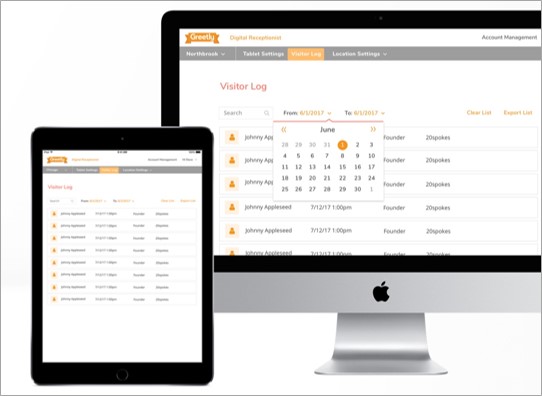How Visitor Management Systems Ensure Workplace Emergency Preparedness
Executive Summary
- Emergencies still occur, and emergency preparedness is essential for ensuring the safety of staff and visitors in all offices and manufacturing sites.
- Authorities and standard-setting organizations require that businesses develop and implement emergency action plans, which increases the efficiency of emergency response.
- Visitor management systems offer a range of functionalities that can streamline emergency evacuation. The visitor log, instant evacuation notifications and tracking, and improved onsite transparency can help emergency responders and make your workplace safer.
Despite all governmental and organizational efforts to prevent emergencies, crises still occur and impose threats on people, facilities, and businesses alike. In such situations, emergency preparedness and evacuation plan can be a lifesaver and make the difference between survival and fatality.
The National Fire Protection Agency reports a 13% rise in workplace fire incidents totaling 111,000 fires in 2020. This is just one of the multitude of emergencies that could put your employees’ and visitors’ safety at risk.
Earthquakes, hurricanes, and other natural disasters would also require an immediate emergency response. Looking at statistics, 2021 saw 432 natural disastrous events globally affecting 101.8 million people and resulting in economic losses of more than $252 billion.
The moment your workers and visitors step into your office or manufacturing site, their safety becomes your primary responsibility and concern. Emergency preparedness is not a matter of choice. It’s a “must.”
In this article, we’ll walk you through the elements and the importance of emergency preparedness. We’ll also highlight the ways a visitor management system can help you make your manufacturing site and office a safe place to work and visit.
First things first…
What Is Emergency Preparedness?
 Emergency preparedness refers to all the activities you take in advance to make sure you, your employees, and visitors are safe at all times when an accident or a disaster occurs. Examples of natural disasters include earthquakes, floods, hurricanes, tornadoes, and other extreme weather events. Among the most frequent man-made disasters are fires, explosions, and toxic chemical spills.
Emergency preparedness refers to all the activities you take in advance to make sure you, your employees, and visitors are safe at all times when an accident or a disaster occurs. Examples of natural disasters include earthquakes, floods, hurricanes, tornadoes, and other extreme weather events. Among the most frequent man-made disasters are fires, explosions, and toxic chemical spills.
Emergency preparedness encompasses three main stages:
1. Emergency Planning
This is the stage where emergency planners should outline every activity and arrangement designed to reduce the impact of emergency situations:
- Prevention: focusing on providing protection from disasters and limiting the loss of life
- Risk assessment: identifying possible disasters in vulnerable areas and focusing on mitigation efforts.
- Mitigation strategies: aiming to limit vulnerabilities depending on the particular type of emergency (through disaster-specific means and facilities)
- Establishing a response team: defining leaders, roles, and responsibilities during an emergency
- Emergency action plan development: simplifying the organization process so that everyone knows their responsibilities.
2. Emergency Response
This is the stage where you execute the emergency plan so you can limit the loss of life. A primary aspect of emergency response is to ensure seamless coordination with regional emergency crews. Generally, the two applied approaches involve either sheltering in place or evacuation from the affected facility.
3. Salvage and Recovery
The salvage and recovery stage comes into play when the threat is under control, and the function of your facility returns to normal operation.
Let’s take a look at the most important reasons for ensuring emergency preparedness on your administrative and manufacturing sites.
Why Do All Workplaces Need to Be Prepared?
First of all, many jurisdictions require an emergency action plan.
The Occupational Safety and Health Administration (OSHA), for example, requires that all companies have an emergency action plan that includes detailed evacuation procedures. OSHA standards require written emergency action plans. What’s more, businesses with more than ten workers must post a written copy of the evacuation plan visible to the employees during an emergency.
Also, the National Fire Protection Association, the American National Standards Institute, and other standards-setting organizations set consensus standards and additional requirements and guidelines for emergency planning. The NFPA has established consensus codes and standards applying to all designs, processes, facilities, and installations. They are focused on limiting fire risk and effects through clear emergency procedures and the availability of a fire evacuation map.
So, the development of an emergency action plan is a matter of meeting officially set standards and requirements. Apart from complying with them, ensuring emergency preparedness brings in a multitude of benefits:
- It sets out clear steps and procedures in case of an emergency
- With 40% of businesses failing to resume their operations after a disaster, emergency preparedness can help you recover and reopen
- It ensures that the necessary equipment is in place
- It helps keep employees and visitors safe even in case of a mass evacuation
- Emergency preparedness and the availability of an evacuation plan help prevent panic and promote composure and calmness of both employees and visitors
- Preparedness increases the efficiency of emergency response and responders’ efforts
So, having a well-designed and practiced emergency evacuation plan is crucial for ensuring that the necessary equipment, procedures, and tactics are in place – ready to use and known by everyone in your organization.
How a Cloud-Based Visitor Management System Can Be a Central Element of Your Emergency Evacuation Plan
Easy Triggering of the Emergency Evacuation Feature
Fast and Reliable Emergency Evacuation Notifications
Accounting for Visitors and Employees On-Site
Improved Coordination with Emergency Services
The benefits of implementing a visitor management system have long gone beyond just easy and fast sign-in of guests and creating an outstanding first impression. Such a cloud-based solution can also be a powerful tool in emergency situations requiring a prompt and effective response.
Here are six ways in which a visitor management system can be the heart of your emergency evacuation plan and help you make sure that the people on your premises are safe.
1. Enhanced Onsite Transparency
 Modern visitor management includes digital receptionist software that allows you to know who’s on your premises both currently and historically. You can keep track of your visitors and gain real-time insights into all guests present at your facilities at any time.
Modern visitor management includes digital receptionist software that allows you to know who’s on your premises both currently and historically. You can keep track of your visitors and gain real-time insights into all guests present at your facilities at any time.
The visitor log provides detailed information including your visitors’ names and host employees so that you can easily locate them in case of emergency. A full-fledged visitor management system offers the option to take a photo of your guests, which makes them easy to identify. All this data can help emergency crews respond effectively to the crisis on your premises.
2. Easy Triggering of the Emergency Evacuation Feature
Acting quickly is vital during accidents and disasters. Taking into account the panic and distress that accompany such an event, having the right solution in place is paramount. An effective visitor management system comes with an emergency evacuation feature that can be triggered from any web-enabled device, eliminating the need to use dedicated hardware.
Just a couple of taps on the smartphone browser will allow you or any of your admins to use this functionality to take care of the safety of both your staff and visitors.
3. Fast and Reliable Emergency Evacuation Notifications
Did you know that the activation of emergency communications plans takes more than 5 minutes for two-thirds of organizations? And in 10% of cases, it takes more than an hour to activate emergency communications responses. On the other hand, visitor management software can be instantly used to send an evacuation notice to all employees and visitors on-site in the event of a fire evacuation or other accidents. This allows you to take care of the safe clearing of your premises if a disaster occurs.
Admins can trigger instant text messages and email notifications. The alerts are customizable and can include an evacuation map, which helps people find the fastest route to safety. This is particularly valuable for first-time visitors or guests that don’t know your site very well.
4. Data Availability
Imagine the distress of an emergency striking your premises. Would you be able to grab your visitor management database or a paper logbook while running out the door?
A cloud-based visitor management system enables you to literally take all your office documentation and log data with you. You can install the software on many mobile and desktop devices, and each of them will provide you with access to your database, which is securely stored in the cloud.
You’ll know the precise number of people onsite, their names, and recent whereabouts even when you’ve left your premises. This information is essential for ensuring effective emergency response and supporting search and rescue crews.
5. Accounting for Visitors and Employees On-Site
 In a crisis, a top priority is to ensure that everyone is evacuated and accounted for. The emergency alerts sent through the visitor management system can include a link that recipients can tap to indicate that they’ve made it out safely. This accelerates the roll call and allows keeping track of who’s safe and who’s unaccounted for.
In a crisis, a top priority is to ensure that everyone is evacuated and accounted for. The emergency alerts sent through the visitor management system can include a link that recipients can tap to indicate that they’ve made it out safely. This accelerates the roll call and allows keeping track of who’s safe and who’s unaccounted for.
The running list can be shared with rescue crews to increase the efficiency of their emergency response activities. Thus, implementing a front desk sign-in solution can keep workers, visitors, and emergency responders safe.
6. Improved Coordination with Emergency Services
At the time of a crisis, information is crucial and the more details you can provide to emergency responders, the more effective their efforts will be.
A visitor management solution enables you to collect and use important data like the number of the people that are unaccounted for, their last known whereabouts, and any additional information that may facilitate the investigation. This can help search and rescue crews locate such employees and visitors faster, which can be critical.
Conclusion – This Is Not a Drill: Implement a Visitor Management System to Ensure Emergency Preparedness
Providing safety for your workers and visitors is your primary responsibility. A visitor management system streamlines the communication and coordination needed to respond timely and effectively in case of accidents and disasters. It can contribute to building a robust emergency action plan, which will help mitigate the risk and minimize fatalities.
It’s not about whether an emergency will strike. It’s about preparing yourself in the best way possible. Time and information are your strongest allies and a front desk sign-in solution gives you both.



